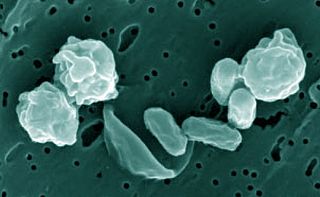
Penicillin is a group of antibiotics which include penicillin G, penicillin V, procaine penicillin, and benzathine penicillin. Penicillin antibiotics were among the first medications to be effective against many bacterial infections caused by staphylococci and streptococci. They are still widely used today, though many types of bacteria have developed resistance following extensive use.
Dictyoglomus is a genus of bacterium, given its own subphylum, called the Dictyoglomi. This organism is extremely thermophilic, meaning it thrives at extremely high temperatures. It is chemoorganotrophic, meaning it derives energy by metabolizing organic molecules. This organism is of interest because it elaborates an enzyme, xylanase, which digests xylan, a heteropolymer of the pentose sugar xylose. By pretreating wood pulp with this enzyme, paper manufacturers can achieve comparable levels of whiteness with much less chlorine bleach.

Bacillus subtilis, known also as the hay bacillus or grass bacillus, is a Gram-positive, catalase-positive bacterium, found in soil and the gastrointestinal tract of ruminants and humans. A member of the genus Bacillus, B. subtilis is rod-shaped, and can form a tough, protective endospore, allowing it to tolerate extreme environmental conditions. B. subtilis has historically been classified as an obligate aerobe, though evidence exists that it is a facultative anaerobe. B. subtilis is considered the best studied Gram-positive bacterium and a model organism to study bacterial chromosome replication and cell differentiation. It is one of the bacterial champions in secreted enzyme production and used on an industrial scale by biotechnology companies.

Bacillus megaterium is a rod-like, Gram-positive, mainly aerobic spore forming bacterium found in widely diverse habitats. With a cell length of up to 4 µm and a diameter of 1.5 µm, B. megaterium is amongst the biggest known bacteria. The cells often occur in pairs and chains, where the cells are joined together by polysaccharides on the cell walls.

Dipicolinic acid is a chemical compound which composes 5% to 15% of the dry weight of bacterial spores. It is implicated as responsible for the heat resistance of the endospore.
Bacillus halodurans is a rod-shaped, Gram-positive, motile and spore-forming bacterium found in soil. In a genomic comparison with Bacillus subtilis, B. halodurans strain C-125 - originally an unclassified Bacillus strain - was found to contain unique genes and sigma factors that may have aided its adaptation to more alkaline environments.
Bacillus clarkii is a facultative anaerobe bacterium. It is a gram positive, alkaliphilic and alkalitolerant, aerobic endospore-forming bacteria.
Quorum-quenching N-acyl-homoserine lactonase (EC 3.1.1.81, acyl homoserine degrading enzyme, acyl-homoserine lactone acylase, AHL lactonase, AHL-degrading enzyme, AHL-inactivating enzyme, AHLase, AhlD, AhlK, AiiA, AiiA lactonase, AiiA-like protein, AiiB, AiiC, AttM, delactonase, lactonase-like enzyme, N-acyl homoserine lactonase, N-acyl homoserine lactone hydrolase, N-acyl-homoserine lactone lactonase, N-acyl-L-homoserine lactone hydrolase, quorum-quenching lactonase, quorum-quenching N-acyl homoserine lactone hydrolase) is an enzyme with systematic name N-acyl-L-homoserine-lactone lactonohydrolase. This enzyme catalyses the following chemical reaction
Bacillolysin is an enzyme. This enzyme catalyses the following chemical reaction
Bacillus sporothermodurans is a species of bacteria notable for producing highly heat-resistant endospores, hence its name. It is strictly aerobic. Its type strain is M215.

Bacillus isolates have a variety of biotechnological applications.
Bacillus vallismortis is a species of bacteria, with type strain DV1-F-3.
Bacillus horti is a species of Gram-negative alkaliphilic bacillus. Its cells are strictly aerobic rods that produce subterminally located ellipsoidal spores. Its type strain is K13T.
Clostridium straminisolvens is a moderately thermophilic, aerotolerant and cellulolytic bacterium. It is non-motile, spore-forming, straight or slightly curved rod, with type strain CSK1T. Its genome has been sequenced.
Brevibacillus borstelensis is a Gram-positive, aerobic, rod-shaped, endospore-forming bacterium of the genus Brevibacillus. The genome of several B. borstelensis strains have been sequenced.
Bacillus fastidiosus is an aerobic, motile, rod-shaped bacterium that has been isolated from soil and poultry litter. The species was first isolated and described by the scientist Den Dooren de Jong in 1929. This organism is a mesophile that contains ellipsoidal spores that do not cause swelling of the sporangia. Bacillus fastidiosus is only able to grow in the presence of uric acid, allantoin, or allantoic acid.
Streptomyces graminearus is a bacterium species from the genus of Streptomyces. Streptomyces graminearus produces the antibiotic gougerotin.
The Bacillus Spore Morphogenesis and Germination Holin (BSH) Family is a family of proteins named after a holin in Bacillus subtilis described to be involved in spore morphogenesis and germination by Real et al (2005). The gene encoding this holin is ywcE. Mutants lacking this gene or its product have spores that exhibit outer coat defects. These spores lack the characteristic striatal pattern resulting in the failure of the outer coat to attach to the underlying inner coat. Finally, the mutant spores accumulate reduced amounts of dipicolinic acid. BSH proteins average about 90 amino acyl residues in length and exhibit 3 transmembrane segments (TMSs). A representative list of homologous proteins, found only in Bacillus species, is available in the Transporter Classification Database.
Arthrobacter rhombi is a Gram-positive, aerobic, non-spore-forming and non-motile bacterium species from the genus of Arthrobacter which has been isolated from the halibut Reinhardtius hippoglossoides.








